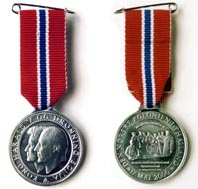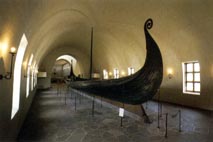![]() GRATULERER MED DAGEN NORGE
GRATULERER MED DAGEN NORGE ![]()
by Peter Cummins
Situated in the northwestern corner of Europe, Norway
shares a common Eastern frontier with Russia, for 196 km, Finland, 716 km
and Sweden for 1620 km, this boundary extending from the extreme South to
the Far North of the Scandinavian Peninsula. The coastlines are pounded by
the Arctic Sea in the North, the Atlantic Ocean on the West and the North
Sea in the South.
His Majesty King Harald
It is no surprise then, that the Norwegians have traditionally embraced - and have always relied upon - the sea for their economic, political and social betterment. With a coastline of some 2,600 km. which, added to the fjords and myriads of islands, inlets and skerries, amounting to some 60,000 km, the Norwegians live, according to most sources, "between mountains, the coast and the waterways."
Norway, apart from its magnificent scenery, clean, healthy environment and a high level of political and social development, is a country of many "superlatives." The highest mountain peak, "Galdhopiggen" at 2,470 metres above sea level, is the highest mountain in Europe, north of the Alps.
Norway is one of the largest countries of Europe, with a total area of some 390,000 sq. km which includes the 62,000 sq km of the Svalbard Islands.
With a population of some four and a half million, Norway is one of the least-densely populated countries of Europe and its people, as has been observed by many, "do not suffer from a lack of space." On the contrary, the Norwegian’s fierce love of the outdoors allows each and every individual to enjoy the infinity of the mountains, the green, green forests, the fjords, lakes and coast-lines. The total country is every citizen’s huge open-air playground - all year round!
Norway boasts the world’s northern-most city, Hammerfest. The whole country is so far north, in fact, that the Arctic Circle divides Norway in two.
Yet, in spite of its northern latitude, Norway enjoys a relatively mild climate, because of the Gulf Stream, which propels the warm waters of the Caribbean north across the Atlantic and up along Norway’s western coast. Even in the depth of winter, then, Norway’s ports and harbours are usually ice-free.
 Thousands
of people flock to Aker Brygge, The Royal Palace, Akershus Castle and Oslo’s
main street Karl Johan.
Thousands
of people flock to Aker Brygge, The Royal Palace, Akershus Castle and Oslo’s
main street Karl Johan.
Each year the Norwegians observe the 17th of May as their National Day, celebrating independence. It is also a day dedicated to children who have special events, marches, dancing and singing as the procession moves towards the Royal Palace where King Harald V and the members of the Royal Family traditionally greet the crowds from the Palace balcony.
Like Thailand, Norway is a Constitutional Monarchy and the present King Harald V acceded to the Norwegian Throne after the death of his father, Olav V in 1991. King Harald, Queen Sonja and the two children Crown Prince Haakon and Princess Martha Louise are revered by the Norwegian people and share the natural splendours of the Kingdom with the people.
Due, no doubt, to the Norwegians’ propensity to preserving their remarkable lifestyle in a clean, salubrious environment close to Nature, strict legislation protects this precious resource and unlike many other developed - and developing - countries, commercial exploitation of the natural resources is subject to the environmental consequences.
In 1972, Norway, in fact, was the first country to establish a Ministry of Environment and former Prime Minister Gro Harlem Brundtland was elected as President of the United Nations World Commission for the Environment and Development. Through her tireless work, she was able to bring issues of sustainable development to the attention of the governments of the world.
Norway has always played a strong role in international foray and has been a staunch supporter of the United Nations and the world body’s goals, particularly peace-keeping operations.
The first Secretary-General of the United Nations, in fact, Trygve Lie, was Norwegian and Ms. Gro Harlem Brundtland is now Director-General of the World Health Organization in Geneva.
 Lars
A. Wensell, Ambassador of Norway to Thailand
Lars
A. Wensell, Ambassador of Norway to Thailand In
that cold land, so far away in the northern hemisphere, it has also become
a day for children. Some Norwegians who have settled here in Thailand have
decided that the children here should also benefit from the May 17th
celebrations.
In
that cold land, so far away in the northern hemisphere, it has also become
a day for children. Some Norwegians who have settled here in Thailand have
decided that the children here should also benefit from the May 17th
celebrations. (left
to right) Jan Olav Aamlid, museum director Oystein Koch Johansen,
Gunnar These, Jaqueline Beer and Thor Heyerdahl. (Photo by Frits
Solvang)
(left
to right) Jan Olav Aamlid, museum director Oystein Koch Johansen,
Gunnar These, Jaqueline Beer and Thor Heyerdahl. (Photo by Frits
Solvang)
 The
Kon-Tiki Raft on display at Thor Heyerdahl’s Kontiki Museum in Bygdøy,
Oslo.
The
Kon-Tiki Raft on display at Thor Heyerdahl’s Kontiki Museum in Bygdøy,
Oslo.